31-434 Midland Class 1f 41803 British Railways Black DCC Sound Oil Lamps Firebox

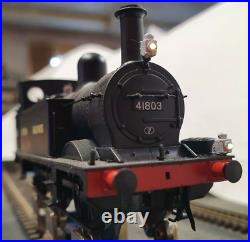
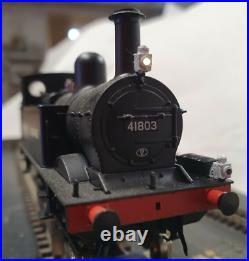
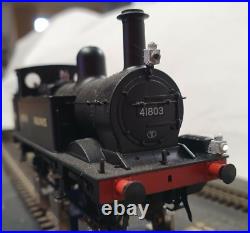
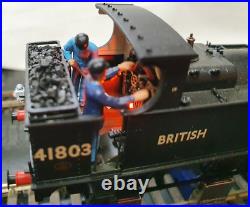
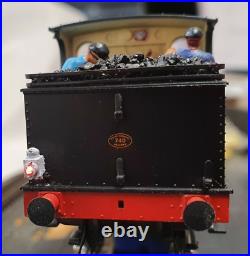
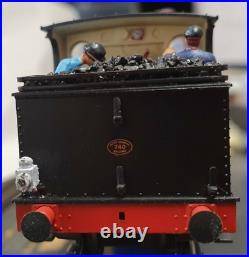
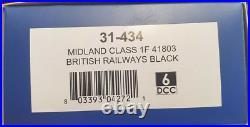

31-434 MIDLAND CLASS 1F 41803 BRITISH RAILWAYS BLACK CONVERTED TO SOUND, LIGHT, FIREBOX, AND CREW BY CR SIGNALS. BRIEF HISTORY OF THE LOCOMOTIVE. The Midland Railway 1377 Class was a class of 185 0-6-0T tank locomotives.
They were introduced in 1878 by Samuel W. Johnson, and were almost identical to the 1102 class of 1874; the latter having fully enclosed cabs, while the 1377 class were built without a rear to the cab and only a short cab roof, hence their nickname "half-cabs". They were given the power classification 1F. All 185 passed to the London, Midland and Scottish Railway (LMS) at the grouping in 1923. Withdrawals started in 1927 and by 1948 when the railways were nationalised, 72 locomotives passed into British Railways ownership in 1948 and they allocated numbers 40000 higher than their LMS numbers, although 14 were withdrawn before the new numbers were applied. Withdrawals continued and by 1961 only 11 remained; the last five were withdrawn in September 1965. The class had only lasted as long as it had because the Midland Railway had signed a contract in 1866 to provide shunting engines to Staveley Ironworks for 100 years; the 1Fs, as they were by then, were the only locomotives suitable to perform this duty. Beyond their work with the Midland Railway, LMS and British Railways, six members of this class - 1666, 1708, 1751, 1788, 1839 and 1890 - were requisitioned by the War Department during World War II between 1940 and 1944, to operate the Melbourne Military Railway (MMR) in South Derbyshire. 1839 was replaced by No. 1773 during its time on the MMR. FULL DCC SOUND CONVERSION OF BRAND NEW MODEL BY CR SIGNALS. WORKING LED LIGHTS, INCLUDING LAMPS AND FIREBOX. SOUND USING A LOKSOUND 5 MICRO WITH FILE PROVIDED BY BR SOUNDS. Front Oil Lamps and Rear Red Lamps (If Fitted). Class F Lamp Code with rear red lamp (Turned off with F16).The locomotive will start to push a wagon, coach, etc a short distance at approximately 15 mph scale speed, before returning to its original position. For use with automatic uncoupling track sections, magnets etc.
(CV 246 = 30, CV 247 = 60, CV 248 = 60). A replacement for the Dynamic Braking as seen on CR Signals locomotives fitted with the LokSound V4. Service Brake is your standard brake mode, and will decrease the stopping time by approximately 80%, giving the user more control over deceleration.
Activating the Service Brake will also start to steadily reduce and limit the speed of the locomotive to approximately 45mph (about half the top speed), giving the user the ability to "Cruise" the locomotive at a steady pace, without adjusting the throttle e. On the approach to the station or junction, you can leave the throttle wide open, and activate F5, the locomotive will start to slow through the station, once the locomotive has cleared the station you can deactivate F5, and the locomotive will start to power away. Shovelling & Firebox Glow (If Fitted). Rear Light On / Off (If Fitted).
Front Oil Lamp and Red Lamp (If Fitted). Class B and Rear Lamp (Turned off with F16). Class K and Rear Lamp (Turned off with F16). Light Engine / Heavy Train Modes.
With F22 switched off (the default setting) the locomotive will behave as if it is running without load (Light Engine), quickly accelerating away and stopping in much shorter distances. Activating F22 will switch the Locomotive into Heavy Train Mode, greatly increasing the acceleration times, and simulating the amount of power the engine needs when accelerating.
Increase the stopping distances of the locomotive, when compared to Light Engine. Referred to as "Optional" and "Primary" load by ESU. Reduces the braking distance by 40% and limits the top speed to approximately 30mph. For more control of speed, in and around stations. Can be used with F5 for increased braking. Reduces the braking distance by 20% and limits the top to approximately 15mph. For more control of speed, in and around yards. This item is in the category "Collectables\Model Railways & Trains\Railways & Trains\Locomotives". The seller is "cr_signals" and is located in this country: GB. This item can be shipped to United Kingdom, Antigua and Barbuda, Austria, Belgium, Bulgaria, Republic of Croatia, Cyprus, Czech Republic, Denmark, Estonia, Finland, France, Germany, Greece, Hungary, Ireland, Italy, Latvia, Lithuania, Luxembourg, Malta, Netherlands, Poland, Portugal, Romania, Slovakia, Slovenia, Spain, Sweden, Australia, United States, Bahrain, Canada, Brazil, Japan, New Zealand, China, Israel, Hong Kong, Norway, Indonesia, Malaysia, Mexico, Singapore, South Korea, Switzerland, Taiwan, Thailand, Bangladesh, Belize, Bermuda, Bolivia, Barbados, Brunei Darussalam, Cayman Islands, Dominica, Ecuador, Egypt, Guernsey, Gibraltar, Guadeloupe, Grenada, French Guiana, Iceland, Jersey, Jordan, Cambodia, Saint Kitts-Nevis, Saint Lucia, Liechtenstein, Sri Lanka, Macau, Monaco, Maldives, Montserrat, Martinique, Nicaragua, Oman, Pakistan, Peru, Paraguay, Reunion, Turks and Caicos Islands, Aruba, Saudi Arabia, South Africa, United Arab Emirates, Chile, Bahamas, Colombia, Costa Rica, Guatemala, Honduras, Jamaica, Kuwait, Panama, Philippines, Qatar, Trinidad and Tobago, Vietnam.- Power Type: DC
- Assembly Status: Ready to Go/Pre-built
- Corporate Livery: British Rail
- Vehicle Type: Locomotive
- Replica of: Midland Railway 1377 Class
- Wheel Configuration: 0-6-0
- MPN: 31-434
- Scale: 1:76.2
- Material: Plastic, White Metal
- Control System: Digital
- Gauge: OO
- Colour: Black
- Vintage: No
- Brand: Bachmann
- Type: Steam Locomotive
- Rail System: Two-Rail System
- Era: Era 4 - British Railways Steam Era (1948-1956)
- Features: DCC fitted, Light function, Sound function
- EAN: 803393042721
